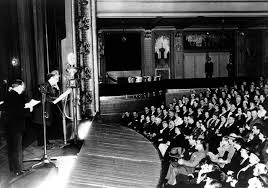"Selling Hope as Feverishly as Soap": The Way It Was, 19 January
1905---A daughter is born to a Baltimore police lieutenant, who thinks young ladies unfit for college, but will see her grow up to begin her adult life as a journalist but find happiness and make history, in due course, as the co-mastermind (with her second husband) of over thirty radio soap operas, a majority of which will be created and become hits during the Depression they come to outlive
Anne Schumacher will return from overseas unable to find new journalism work in Chicago, join the Blackett-Sample-Hummert advertising concern, rise to a vice presidency by age 28, and co-produce, with the third of the concern's title triumvirate, a serial called The Stolen Husband (1931), which eventually graduates to the more familiar Betty and Bob.
She and her new collaborator will go from there to create Just Plain Bill (1932-1955), whose protagonist's barbershop will often need about fifty episodes (or so it will seem) to find a customer at all, never mind one as riveting as his family and friends.
Divorced from her first husband (fellow journalist John Ashenhurst), she will marry that collaborator, widower Frank Hummert, three years after their first creation goes on the air and, after forming Air Features, Inc., they move it to New York and themselves to Connecticut, co-administering an operation in which husband and wife create, produce, and exercise firm, rarely compromising oversight with every one of their creations, thus finalising the soap opera as it has remained for the most part even after the genre transitions from old-time radio to television.
And she becomes thus the creator, co-producer, and head writer for, among other soaps, Backstage Wife (a.k.a. Mary Noble, Backstage Wife, 1935-1939; creator-producer-writer), Ma Perkins (1933-1960), John’s Other Wife (1936-1942), The Romance of Helen Trent (1933-1960), Our Gal Sunday (1937-1959), Lorenzo Jones* (1937-1955), Stella Dallas (1937-1955), Mr. Keen, Tracer of Lost Persons (1937-1955), Second Husband (1936-1946), The Strange Romance of Evelyn Winters (1944-1948), Young Widder Brown (1938-1956), Mr. Chameleon (1948-1953), and The Life of Mary Sothern (1934-1943), for openers.
She will not achieve this without controversy, if one believes the often-enough told tale that---upon her insistence that God be on every page of every script---one of her writers will ask, "Who's going to play the part?" and be rewarded with her head on the proverbial plate. But our heroine has sense of humour enough to let Bob & Ray’s murderous satires of at least two of her co-creations (the famous running routines, "Mary Backstage, Noble Wife" and "Mr. Trace, Keener Than Most Persons") roll off her back, perhaps knowing a murderous satire isn't half as murderous as a sheaf of (radio and sometimes social) critics' dismay.
No matter the devices and underwritings that become cliche perhaps too soon, she and her husband/partner sell hope as feverishly as soap, in the eventual phrase of historian Gerald Nachman. And Anne Hummert will retire in due course only after the Hummert soaps lose their sponsors to television after 1960 and after her husband dies in 1966.
Despite the competition, the Hummerts were the General Motors of daytime radio, pumping out 5 million words a year . . . their programs brought in some $1 million a week in billings and, it's said, 50 million letters a year. The couple leaped on the broadcasting bandwagon precisely when radio was hitching its own wagon to Madison Avenue. They saw that daytime was laying fallow and, in spite of advertisers' resistance to pitching products to what they felt was a nation of non-listeners, literally seized the weekday by populating morning and afternoons with serial dramas.---Gerald Nachman, from Raised on Radio (New York: Pantheon Books, 1998).The Hummerts have employed two hundred serial writers since they went into radio. They have fourteen on the staff now, and they can call on a reservoir of thirty others. The Hummerts think up their own ideas for serials. When they do, Mrs. Hummert writes an outline of the plot, suggesting incidents for the first three months or so and indicating key dialogue. Copies of this are given to five writers, and the one whose sample script seems to hit it off best is picked to do the serial. He is given an opportunity to write at least five scripts in advance, and frmo then on is supposed to stay that far ahead. When Ned Calmer, now a news commentator, was writing a Hummert serial, Backstage Wife, he built up a backlog of nineteen scripts so that he could take a trip to Mexico. When the story line was suddenly changed, for some reason or another, he had to cancel his vacation and start all over again. For the last year, Mrs. Hummert has delegated some of her work, but before that she personally kept the story lines of all the serials going by turning out synopses for her writers.---James Thurber, from "Soapland," The New Yorker, 1948, republished in The Beast in Me: A New Collection of Pieces and Drawings About Human Beings and Less Alarming Creatures. (New York: Harcourt, Brace and Company, 1949.)The silence throbs . . . the empty hours are endless . . . then a friend in need is brought into the room by the turning of a dial. Misery loves company . . . Worry, for women, is entertainment . . . Nobody can understand the phenomenal success of the soaps without knowing when they were born. It was during the Depression. The housewife was at home worrying about everything. Would her husband lose his job? Where was the family's next meal coming from? They found escape in the lives of the people on the soaps.---Anne Hummert, from rare interviews late in her life, as cited by Nachman.
CHANNEL SURFING . . .
1945: THE POLICEMAN'S BALL---The good news: Linda Darnell ("and, brudder, would I like to fence her in") is going to crown Archie (Ed Gardner) king of the policeman's ball; the bad news: nobody bothered to ask Darnell, just yet, on tonight's edition of Duffy's Tavern. (First broadcast: CBS; rebroadcast: AFRS.)
Finnegan: Charles Cantor. Eddie: Eddie Green. Miss Duffy: Sandra Gould. Music: Matty Malneck Orchestra. Writers: Ed Gardner, possibly Larry Gelbart, possibly Larry Rhine.
1948: BAKER'S DOZEN---A baker (Ernest Chappell, who also narrates), who can never bring himself to give a customer a baker's dozen out of superstition, finds himself now on a trial jury . . . where he is stunned to see thirteen jurors, not twelve, with the thirteenth seen only by himself but sensed by one other in court, on tonight's edition of Quiet, Please. (Mutual.)
Elsa: Lana Stavisky. District attorney: Jim Bowles. Gaffigan: Ed Lattimer. Murray: Charlie Brooks. Judge: Harry Werth. Writer: Wyllis Cooper.
1951: THE CLOAK AND DAGGER CAPER; OR, "THE SAME OLD SUIT, THE SAME OLD SHREDS"---Such is Dashiell Hammett's hero's (Steve Dunn) sartorial splendor as his rainy night peace and quiet and Time magazine reading is rudely interrupted, by a lady named Shalamar for openers, on tonight's edition of The Adventures of Sam Spade. (NBC.)
Effie: Lurene Tuttle. Writer: Bob Tallman.
1954: WORKING ON THE TOASTER TO FORGET THE CONTEST---"There are two schools of thought on that, and I'm a graduate of both of them," warbles Molly (Marian Jordan) to her mate (Jim Jordan), when he boasts yet again of his handyman virtuosity---this time, taking his mind off a newspaper contest to identify "Citizen X" by trying, with his usual lack of style, to fix the toaster when a slice of bread gets stuck and burns, on today's/tonight's edition of Fibber McGee & Molly. (NBC.)
Doc: Arthur Q. Bryan. Writer: Phil Leslie.
PREMIERING TODAY . . .
1866---Harry Davenport (actor: Screen Guild Theatre; Family Theatre), New York City.
1887---Alexander Woollcott (commentator: The Early Bookworm; Town Crier), Phalanx, New Jersey.
1906---Lanny Ross (singer: The Lanny Ross Program; Maxwell House Show Boat), Seattle.
1908---Ish Kabibble (as Merwyn Brogue; cornetist/comedian: Kay Kyser’s Kollege of Musical Knowledge), Erie, Pennsylvania.
1919---Ray Eberle (singer, with Glenn Miller and His Orchestra: Numerous radio remotes and short programs), Hoosick Falls, New York.
1922---Guy Madison (actor: Wild Bill Hickok), Pumpkin Center, California.
1935---Tippi Hedren (as Nathalie Kay Hedren; actress: World's Fair Holiday), New Ulm, Minnesota.
1887---Alexander Woollcott (commentator: The Early Bookworm; Town Crier), Phalanx, New Jersey.
1906---Lanny Ross (singer: The Lanny Ross Program; Maxwell House Show Boat), Seattle.
1908---Ish Kabibble (as Merwyn Brogue; cornetist/comedian: Kay Kyser’s Kollege of Musical Knowledge), Erie, Pennsylvania.
1919---Ray Eberle (singer, with Glenn Miller and His Orchestra: Numerous radio remotes and short programs), Hoosick Falls, New York.
1922---Guy Madison (actor: Wild Bill Hickok), Pumpkin Center, California.
1935---Tippi Hedren (as Nathalie Kay Hedren; actress: World's Fair Holiday), New Ulm, Minnesota.
* - Recall, if you will, that Lorenzo Jones was actually a kind of anti-soap: a serial comedy told from a male perspective, at the time rare for Soapland, and centered around an inventor whose inventions made little sense but whose mishaps provided "comic relief from the incessant heartache of surrounding serials." (Nachman.)
Lorenzo Jones was also one of the only Hummert serials to be written outside Anne Hummert's dominant eye; the Hummerts hired a couple, Theodore and Mathilde Ferro, and asked them to devise a comic soap. But in due course, the soap's aesthetic was changed; gone was the cheerful insanity and in was what you might call the precursor to the kind of ersatz intrigue-driven, drama-queen style storyline (it only began with Lorenzo losing his hearing and continued with his kidnapping) later made a staple by such as General Hospital
** - You weren't seeing things. When the show was revamped to a five-a-week, fifteen-minute offering (and a serial comedy at that!)---after falling ratings at last for their longtime weekly half hour---NBC elected to air the new Fibber McGee & Molly twice a day, once afternoon and once evening.
It was largely because of co-star Marian Jordan's accelerating health trouble (she would die of cancer, sadly, in 1961---just as the couple were about to re-up for three more NBC years) that, after almost four years as a daily fifteen-minute serial comedy, the show eventually shrank to five-minute segments on NBC's legendary Monitor weekend programming block.












0 Comments:
Post a Comment
Subscribe to Post Comments [Atom]
<< Home